The water level of a river in Brazil’s Amazon rainforest has hit its lowest point in more than 120 years amid a record-breaking drought.
The Rio Negro, the Amazon’s second-largest tributary, in the city of Manaus recorded a water level of 13.59m (44.58ft) on Monday, according to its website – its lowest level since records began in 1902.
The reading passed a previous all-time low set in 2010 and is far lower than measurements taken a year ago, when the level was 17.60m (57.74ft).
It is also significantly lower than 30.02m (98.49ft) registered in June 2021 – its highest on record.
It comes as a drought and high temperatures grip the region, disrupting communities and killing wildlife – and as experts warn the situation in the Amazon is likely to “worsen” due to climate change.
Earlier this month, more than 100 dolphins and thousands of fish were found dead as researchers warned the conditions are making it increasingly difficult for wildlife to survive.
Water temperatures in some parts of the Amazon reached a record 39C (102F).
Low river levels have left hundreds of communities struggling to access drinkable water and disrupted commercial navigation routes on the waterways, leaving vessels stranded.
In July 2021, historic floods in the region ruined crops of hundreds of communities and lasted for about three months.
Philip Fearnside, a researcher at the Brazilian National Institute For Amazonian Research, expects such events in the region are likely to become more frequent and severe due to climate change.
He said surface water in the eastern equatorial Pacific Ocean is now warmer than during the “Godzilla” El Nino of 2015-2016, which drove many extreme global conditions, and is expanding.
Please use Chrome browser for a more accessible video player
In the Amazon, these Pacific warmings primarily lead to droughts in the northern part of the region.
In addition, a warm water patch in the tropical North Atlantic is causing drought in the southern part of the Amazon, according to researchers.
Read more:
This is why it’s so important to protect the Amazon
‘Global warming could wipe out humans’
Mr Fearnside said: “The forecast is for the start of the rains to be delayed compared to normal, and for a drier than normal rainy season.
“This could result not only in extreme low water this year, but also low levels in 2024.
“Until the rainy season begins in the basin, the situation that is already under way should worsen.”








